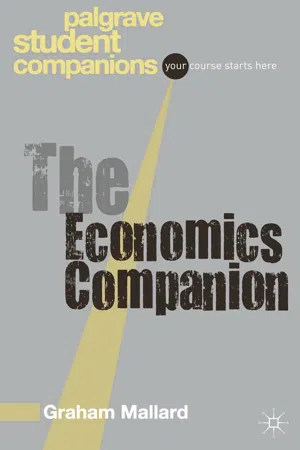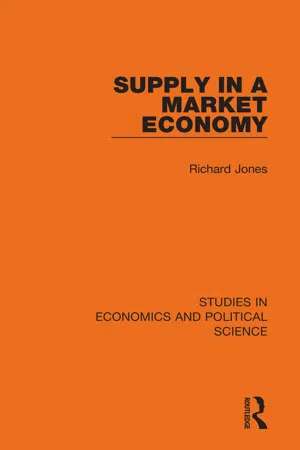Economics
Cost Curves
Cost curves in economics show the relationship between the quantity of goods produced and the costs incurred. The main types of cost curves include the average total cost curve, average variable cost curve, and marginal cost curve. These curves are essential for firms to make production decisions and determine the most efficient level of output.
Written by Perlego with AI-assistance
Related key terms
1 of 5
11 Key excerpts on "Cost Curves"
- eBook - ePub
- Enrico Colombatto(Author)
- 2016(Publication Date)
- Taylor & Francis(Publisher)
The notion of total costs is helpful. It provides an effective synthesis of the outcomes generated by the producers’ choices aiming at efficiency broadly understood, and it is the benchmark with respect to which competitiveness is assessed, since the nearer the firm is to its total-cost curve, the better its short-run position in the industry and its chances to make profits or contain losses. In this and the following sections, we shall go one step further and show that closer inspection of the firm's cost structure also provides useful insights about how producers determine the profit-maximising level of output, about when it pays to stop producing and wait for better times, and about when it is advisable to liquidate the company and quit the industry altogether. Here, however, economics usually departs from total-Cost Curves, preferring instead to focus on ‘average costs’ and ‘marginal costs’. To these categories we now turn our attention.Average cost is total cost divided by the quantity of output. In other words, average cost is the cost per unit of output. Of course, since total costs are the sum of fixed and variable costs, average cost is the sum of average fixed cost and average variable cost. This is illustrated in Figure 4.2 , in which the dashed lines describe average fixed and variable costs, and the continuous lines are average (total) cost. Note that the average fixed-cost curve represented in the figure slopes downward until X1 , the threshold beyond which a new wave of fixed costs needs to be incurred – for example, to increase production capacity. Until that point (X1 ), an increase in output means that a given amount of (fixed) initial costs is spread over larger and larger amounts of goods and services and that, therefore, the burden of such costs per each unit of output becomes lighter and lighter.Figure 4.2 Average Cost CurvesBy contrast, average variable Cost Curves are usually U-shaped. Two things account for this. The first relates to the fact that for low volumes of output, production factors cannot always be fully utilised (e.g., downtime phenomena are frequent). Moreover, an employer operating a small company might have weak bargaining power when hiring inputs or looking for funds to finance operations. When present, such difficulties thus translate into relatively high variable costs per unit of output. However, average variable costs tend to decline as output expands: production factors are put to better use and – perhaps – the entrepreneur's bargaining power strengthens, so that he can employ inputs at a lower cost. Yet, size leads to downward-sloping average variable costs only to a point, beyond which large-scale enterprises are no longer the lowest-cost producers. This phenomenon is due to the presence of a second element of variable costs: organisation and monitoring. Monitoring is necessary to ensure that inputs operate properly, that coordination remains nimble and effective, and shirking is kept within tolerable limits. Typically, the cost of monitoring increases – and its effectiveness decreases – with the size of the company. For example, you may need one supervisor to monitor a team of 15 workers, but three supervisors to coordinate two teams of 15 workers each – one for each team and a senior supervisor to coordinate the teams and the junior supervisors. Furthermore, as the size of the firm increases, the feelings of loyalty and within-group solidarity tend to weaken, which adds to the cost of monitoring. Thus, when the benefits created by more effective exploitation of inputs and stronger bargaining power are outweighed by high monitoring costs and low motivation, average variable costs start increasing. Put differently, one may conjecture that for low volumes of production (until X0 , in our example), size prevails and exerts a downward pressure on average variable costs, which decrease as output increases. For high volumes of production (beyond X0 - eBook - PDF
- Colin Harbury(Author)
- 2014(Publication Date)
- Pergamon(Publisher)
CHAPTER 3 Production: Costs and Organization This chapter is devoted to factors lying behind the supply curve for a product. It focuses on costs of production and the way in which they influence the decisions of business firms in different market situations. The supply curve of an industry is made up of the supply curves of the individual firms within it. Each firm is normally assumed to be trying to maximize its profits and the THEORY OF THE FIRM is concerned with analysing how a business decides upon its most profitable output. The maximum profit position is described as the equilibrium of the firm. Emphasis here is concentrated upon the costs of producing different quantities of a commodity (sometimes known as the COST FUNCTION). Implicit in costs are the alternative ways in which a given output can be produced utilizing different combinations of factors of production (known as the PRODUCTION FUNCTION). The nature of costs normally varies according to the length of time allowed. In the SHORT RUN some factors of production (or INPUTS) are FIXED, and their costs likewise. These fixed, or OVERHEAD COSTS, such as that of a durable machine used in a factory, are sometimes called SUPPLEMENTARY or INDIRECT costs to distinguish them from the VARIABLE, DIRECT or PRIME COSTS, which vary directly as output changes. The LONG RUN is defined as the period within which all costs can be varied. Sometimes a further period, the VERY LONG RUN, is distinguished, when new products and processes can be considered by a firm. In the short run, the existence of fixed costs means that the AVERAGE (or UNIT) TOTAL COSTS (A.T.C) of production start to fall, as fixed costs are spread over larger outputs, until a point is reached where the fixed supply of a factor begins to push A.T.C. up. This gives rise to what is known as the 'U-SHAPED' COST CURVE. AVERAGE FIXED COSTS (A.F.C.) fall as output expands. - eBook - PDF
Microeconomics
Theory and Applications
- Edgar K. Browning, Mark A. Zupan(Authors)
- 2019(Publication Date)
- Wiley(Publisher)
To see its more conventional appearance, refer to Figure 8.2a, which represents Figure 8.1 after its axes have been interchanged. Short-Run Cost Curves Now let’s take a more careful look at the relationship between cost and output by using the firm’s Cost Curves. Figure 8.2a shows the firm’s total Cost Curves, and Figure 8.2b shows the per-unit Cost Curves. The curves have the shapes implied by the data in Table 8.1, but now we wish to see why all short-run Cost Curves are expected to have these same general shapes. 8.3 Figure 8.1 From Total Product to Total Variable Cost The quantity of the variable input is related to output through the total product curve. The total product (TP) curve can be transformed into the total variable cost (TVC) curve by multiplying each quantity of the variable input by its per-unit price. A 0 4 8 Output Hours of labor: the variable input Cost of labor: TVC 18 $180 8 $80 TP (TVC) • Short-Run Cost Curves 187 Little more need be said about the total variable cost curve. In the previous section we explained the way the total variable cost curve is derived from the production function. Total fixed cost, TFC, is a horizontal line at $60, indicating a $60 fixed cost, regardless of output. The TC curve shows total cost, the sum of fixed and variable costs. Note that the TC curve is $60 higher than the TVC curve at each rate of output. The vertical distance between TVC and TC is total fixed cost: both F0 and CD equal $60. Marginal Cost Economic analysis relies more heavily on the per-unit Cost Curves shown in Figure 8.2b, so we devote more attention to them here. Examine the marginal cost curve first. It is -shaped, with the cost of additional units of output first falling, reaching a minimum, and then rising. Marginal cost falls at first because the fixed plant and equipment are not designed to pro- duce very low rates of output, and production is very expensive when output is low. - Walter Nicholson, Christopher Snyder(Authors)
- 2021(Publication Date)
- Cengage Learning EMEA(Publisher)
Due to electronic rights, some third party content may be suppressed from the eBook and/or eChapter(s). Editorial review has deemed that any suppressed content does not materially affect the overall learning experience. Cengage Learning reserves the right to remove additional content at any time if subsequent rights restrictions require it. 242 PART 4 ● Production, Costs, and Supply 8-5 Per-Unit Short-Run Cost Curves The relationship between output and short-run total costs shown in Figure 8.5 can be used in a way similar to what we did earlier in this chapter to define a number of per-unit no-tions of short-run costs. Specifically, short-run average cost can be defined as the ratio of short-run total cost to output. Similarly, short-run marginal cost is the change in short-run total cost for a one-unit increase in output. Because we do not use the short-run/long-run distinction extensively in this book, it is unnecessary to pursue the construction of all of these Cost Curves in detail. Rather, our earlier discussion of the relationship between the shapes of total Cost Curves and their related per-unit curves will usually suffice. One particular set of short-run Cost Curves is especially instructive, however. Figure 8.6 shows the case of a firm with a U-shaped (long-run) average cost curve. For this firm, long-run average costs reach a minimum at output level q * , and, as we have noted in several places, at this output level, MC = AC . Also associated with q * is a certain level of capital usage, K * . What we wish to do now is to examine the short-run average and marginal Cost Curves (denoted by SAC and SMC, respectively) based on this level of capital input. We now look at the costs of a firm whose level of capital input is fixed at K * to see how costs vary in the short run as output departs from its optimal level of q * .- eBook - PDF
Studies in Economics and Political Science
13 Volume Set
- Various(Author)
- 2022(Publication Date)
- Routledge(Publisher)
The average cost associated with any level of output is given by the slope of the line from the origin to the corres- 46 SUPPLY IN A MARKET ECONOMY ponding point on the total cost curve. Minimum average cost obtains at the output at which this ray from the origin is tangential to the curve of total cost. The final column of Table 3.1 contains marginal cost data. Margi- nal cost (MQ is defined as the addition to total cost resulting from the production of one more unit of output. The marginal fixed cost is, of course, always zero. As was explained in Chapter 2, marginal relationships can be read from curves of total values. Marginal cost is given by the slope of the total cost curve or, in the case of a non- linear curve, by the slope of a tangent to the curve at any given point. It will be clear that, as the minimum average cost is given by the tangent of the line from the origin to the total cost curve, and as this tangent also gives the marginal cost at this point, marginal cost equals average cost when average cost is at a minimum. The relationships between the curves are shown in Figure 3.2, which is constructed from the data in Table 3.1. The points to be noted are: 1 AFC declines continuously. 2 AVC at first declines to a minimum and then rises. When AVC is a minimum it equals MC. 3 ATC declines to a minimum then rises. When ATC is a minimum it equals MC. 4 MC first declines, reaches a minimum and then rises. MC equals both AVC and ATC when these curves are at their lowest points. 5 MC is below AVC and ATC when these curves are declining and above them when they are rising. The ATC thus assumes its characteristic U-shape of economic theory. The curves illustrated in Figure 3.2 are typical short-run curves. The U-shape is important in economic theory and is charac- teristic of both the short and long run. The importance of the assumption of a U-shaped curve is made clear when the theory of the perfectly competitive market is considered in Chapter 4. The AVC and AFC curves are most frequently omitted in this analysis, but they are not without importance. In particular, the level of AVC is important in determining whether or not a firm will stay in produc- tion. Fixed costs have to be met anyway, but variable costs can be - eBook - PDF
Microeconomics
A Contemporary Introduction
- William A. McEachern(Author)
- 2016(Publication Date)
- Cengage Learning EMEA(Publisher)
Costs in the Short Run Identify each of the curves in the fol-lowing graph: Cost per unit Quantity C B A 11. Marginal Cost and Average Cost Explain why the marginal cost curve must intersect the average total cost curve and the average variable cost curve at their minimum points. Why do the average total cost curve and average variable cost curve get closer to one another as output increases? 12. Marginal Cost and Average Cost In Exhibit 7 in this chapter, the output level where average total cost is at a minimum is greater than the output level where average variable cost is at a minimum. Why? 13. Long-Run Average Cost Curve What types of changes could shift the long-run average cost curve? How would these changes also affect the short-run average total cost curve? 14. Long-Run Average Cost Curve Explain the shape of the long-run average cost curve. What does “minimum efficient scale” mean? 15. Case Study: Scale Economies and Diseconomies At the Movies Concession stands account for well over half the prof-its at most theaters. Given this, what are the benefits of the stag-gered movie times allowed by multiple screens? 16. Scale Economies and Diseconomies In analyzing scale econo-mies and diseconomies, what’s the difference between the plant level and the firm level? Questions for Review Copyright 2017 Cengage Learning. All Rights Reserved. May not be copied, scanned, or duplicated, in whole or in part. Due to electronic rights, some third party content may be suppressed from the eBook and/or eChapter(s). Editorial review has deemed that any suppressed content does not materially affect the overall learning experience. Cengage Learning reserves the right to remove additional content at any time if subsequent rights restrictions require it. 160 Part 2 Introduction to the Market System 17. Production in the Short Run Complete the following table. - eBook - PDF
Economics
A Contemporary Introduction
- William A. McEachern(Author)
- 2016(Publication Date)
- Cengage Learning EMEA(Publisher)
Costs in the Short Run Identify each of the curves in the fol- lowing graph: Cost per unit Quantity C B A 11. Marginal Cost and Average Cost Explain why the marginal cost curve must intersect the average total cost curve and the average variable cost curve at their minimum points. Why do the average total cost curve and average variable cost curve get closer to one another as output increases? 12. Marginal Cost and Average Cost In Exhibit 7 in this chapter, the output level where average total cost is at a minimum is greater than the output level where average variable cost is at a minimum. Why? 13. Long-Run Average Cost Curve What types of changes could shift the long-run average cost curve? How would these changes also affect the short-run average total cost curve? 14. Long-Run Average Cost Curve Explain the shape of the long-run average cost curve. What does “minimum efficient scale” mean? 15. Case Study: Scale Economies and Diseconomies At the Movies Concession stands account for well over half the prof- its at most theaters. Given this, what are the benefits of the stag- gered movie times allowed by multiple screens? 16. Scale Economies and Diseconomies In analyzing scale econo- mies and diseconomies, what’s the difference between the plant level and the firm level? Questions for Review Copyright 2017 Cengage Learning. All Rights Reserved. May not be copied, scanned, or duplicated, in whole or in part. Due to electronic rights, some third party content may be suppressed from the eBook and/or eChapter(s). Editorial review has deemed that any suppressed content does not materially affect the overall learning experience. Cengage Learning reserves the right to remove additional content at any time if subsequent rights restrictions require it. 160 Part 2 Introduction to the Market System 17. Production in the Short Run Complete the following table. - eBook - PDF
- Graham Mallard(Author)
- 2017(Publication Date)
- Red Globe Press(Publisher)
This means the marginal cost curve of the producer is in fact its supply curve . More precisely, the marginal cost curve is the inverse supply curve , but for clarity the convention is to refer to it simply as the supply curve (which we do from here on). However, you should be aware of the dif-ference between inverse and normal supply curves and when they should each be used. Key term: supply curve The supply curve shows the minimum price the producer requires for each unit at a particular level of output sold. As with demand, the supply curve can be drawn as either the inverse supply curve , which measures price on the vertical axis and quantity supplied on the horizontal axis, thereby representing price as a function of quantity supplied, P=f(Qs); or the normal supply curve , which measures quantity supplied on the vertical axis and price on the horizontal axis, and so represents quantity supplied as a function of price, Qs=f(P). Economists usually use the inverse form for diagrams and the normal form for mathematical calculation (see Section 5.4 and Box 6.2 for discussion of this point). However, there are two caveats to this rule, which are illustrated in Figure 6.6 in which the average cost (AC), average variable cost (AVC) and marginal cost (MC) curves of the producer are presented. The difference between the aver-age cost and average variable Cost Curves is accounted for by average fixed cost, which, following our analysis above, diminish as output expands: shown in the figure by the average cost and average variable Cost Curves converging as out-put expands. First, we see that there may be prices, such as P 1 , that are associated with the two points on the marginal cost curve: a downward-sloping point and an upward-sloping point. - eBook - ePub
- Richard Jones(Author)
- 2021(Publication Date)
- Routledge(Publisher)
Figure 3.1 gives rise to average and marginal curves of the typical U-shape. A straight-line total cost curve would produce equal average and marginal costs, which would be constant for all rates of output. The long-run average and marginal Cost Curves would be the same horizontal straight line.The majority of economists do not accept that the evidence of L-shaped curves requires the typical U-shaped curve to be rejected. This will be clear from an inspection of any textbook. There are two main reasons for this. First, the evidence is by no means overwhelming – much of it refers to public utilities. Second, there is the impact of the methodological issue raised above; that is, many economists would argue that the evidence does not refute the theory of the U-shaped curve because there is not a close relationship between: (a) the theoretical concept of a plant relationship between costs and the rate of output of a homogeneous product in a static world, and (b) the empirical relationship between costs and output in multiproduct enterprises operating in a dynamic environment when all other factors influencing costs may not have been successfully eliminated. Walters summed up this point of view in the following words:'. . . the U-shaped hypothesis does not inspire great confidence. But this is not because it has been refuted by direct empirical evidence. On the contrary this lack of faith is occasioned by the very few opportunities for collecting evidence to refute the data directly ... at least there is no large body of data which convincingly contradicts the hypothesis of a U-shaped long-run cost curve and the fruitful results which depend on it.'11 - P. Hillebrandt(Author)
- 2000(Publication Date)
- Palgrave Macmillan(Publisher)
Costs of the Construction Firm 125 the output shown by the marginal curve. This is because in this area – small for most contracting firms because of the low level of fixed costs – it is covering the additional costs of the project even though it is not making its full contribution to head office overheads. If the marginal cost curve is below the average variable cost curve, the firm should not produce at all. In all this analysis the relevant marginal and average Cost Curves are those related to whatever time period is under consideration. Thus, in the short run the supply curve of the firm will slope upwards to the right fairly steeply. In the long run, the supply curve may be relatively constant for quite large ranges of output, although, assuming unchanged technolo- gies, it would probably eventually turn up. 126 The Supply of Construction 126 11 Market Supply Curves While it is a truism that the supply curve of the market is made up of the total of what the firms in that market are able to supply at various prices, the variability of firms complicates the summation of individual supply curves. Moreover, other factors, which could be ignored for the firm having a relatively small share of the market, may dominate the market supply curve, thus making the total market supply curve different from the sum of the individual firms’ supply curves. These problems are discussed below and the conclusion for the supply curves of the firm and of the market are summarised in Table 11.1. Efficiency of firms If firms were all of equal efficiency, there were no changes in price of factors of production with changes in output, and firms were all aiming to maximise profits, the supply curve of the market would be the same shape as the supply curve of the individual firm (although with different values of output on the horizontal axis).- eBook - PDF
- David Besanko, Ronald Braeutigam(Authors)
- 2020(Publication Date)
- Wiley(Publisher)
Figure 8.13 shows a graph of the short-run total cost curve, the total variable cost curve, and the total fixed cost curve. Because total fixed cost is independent of output, its graph is a horizontal line with the value rK . Thus, STC Q TVC Q rK ( ) ( ) , which means that the vertical distance between STC(Q) and TVC(Q) is equal to rK at every quantity Q. RELATIONSHIP BETWEEN THE LONG-RUN AND THE SHORT-RUN TOTAL Cost Curves Consider again a firm that uses just two inputs, labor and capital. In the long run, the firm can freely vary the quantity of both inputs, but in the short run the quan- tity of capital is fixed. Thus, the firm is more constrained in the short run than in the long run, so it makes sense that it will be able to achieve lower total costs in the long run. 8.2 SHORT-RUN Cost Curves short-run total cost curve A curve that shows the minimized total cost of producing a given quantity of output when at least one input is fixed. total variable cost curve A curve that shows the sum of expen- ditures on variable inputs, such as labor and materials, at the short-run cost- minimizing input combination. total fixed cost curve A curve that shows the cost of fixed inputs and does not vary with output. estimates of the output elasticity of total cost for four computer industries: electronic computers, computer storage devices, computer terminals, and computer peripheral equipment. 13 Table 8.5 reports these estimates. For each industry, the estimate of the output elasticity of total cost is less than 1. This indicates that each of these industries is characterized by economies of scale. Unlike the case of electric power generation, however, the estimates are not particularly close to 1, indicating that firms in these industries are not fully exploiting all available scale economies. In an industry such as electronic comput- ers, which consists of multiple producers of products such as personal computers, this is quite possible.
Index pages curate the most relevant extracts from our library of academic textbooks. They’ve been created using an in-house natural language model (NLM), each adding context and meaning to key research topics.










